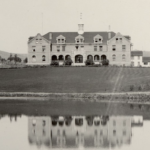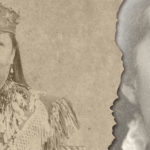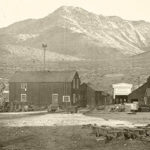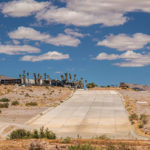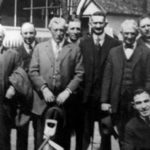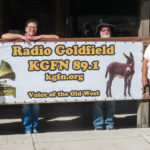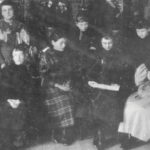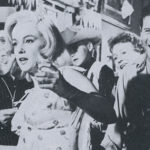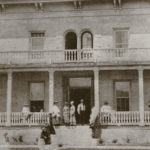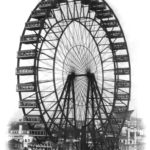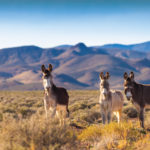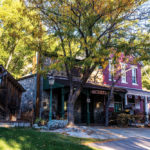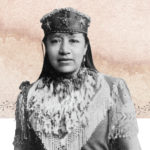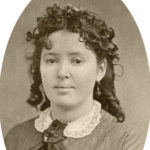View PDF
The Haunting of Lincoln Hall
Lincoln Hall is steeped in mystery, history, and tales of the unexplained. While most souls who entered this 125-year-old dormitory eventually moved on with their lives, not all did. Discover the stories of the past, and learn how you can visit one of the state's most famous university buildings.
View PDF
Sarah Winnemucca
Sarah Winnemucca was born around 1844, near what is today Lovelock. Her name at birth was Thocmetony, and she was a daughter of the leading family of the Kuyuidika-a—a band of the Paiute people.
Within a year of her birth, Winnemucca’s grandfather encountered John C. Frémont—one of the area’s first white explorers—at what is now Pyramid Lake.
View PDF
A Portal Through Time
Some structures are immediately identifiable: The Eiffel Tower, Westminster Abby, and the Space Needle among them. For Nevada ghost town enthusiasts and historians, it’s the façade to the Sutro Tunnel.
The tunnel and adjacent ghost town were closed to visitors for decades, yet the portal remained as a reminder of Comstock Lode and Nevada history. In 2021, Friends of Sutro Tunnel acquired the 150-year-old property, and today, visitors are invited to wander back in time to explore this historic site.
View PDF
The Evolution of Nevada’s Flag
Nothing sparks pride in where you reside quite like a flag. However, creating a banner to represent an entire culture or geographic region isn’t easy work. Nevada’s flag is beloved by residents today, but it took four (almost five) versions until the matter was settled.
View PDF
Silent Echo Bay
During its heyday, Echo Bay—located on the Overton Arm of Lake Mead—supported a hotel, a huge marina, a convenience store, and plenty of visitors. Once the playground of some rather colorful types, it is not quite the attraction it once was, although there is still plenty to see and do in this remarkable area.
View PDF
Nevada’s First Jewish Temple Turns 100
It seems unlikely that the California Gold Rush would spawn Nevada’s first Jewish synagogue. Yet, that’s where Temple Emanu-El’s story begins.
Jewish merchants from the East Coast and Europe joined the mass migration to California in the late 1840s, seeking prosperity as suppliers of goods and services just as they had done back home. When The Comstock Lode hit in 1859, hundreds of merchants headed east to Nevada, settling at what was then called Fuller’s Crossing, a hospitable location for receiving merchandise from San Francisco. Arrival of the Central Pacific Railroad in 1868 made the community—now renamed Reno—an economic hub, and the Jewish community was there to stay.
View PDF
The Real Sound of Rural Nevada
“This is KGFN, Radio Goldfield, the Voice of the Old West!” Chances are if you live in central Nevada or have driven through the area on U.S. Highway 95, you’ve probably heard, or at least heard of, Radio Goldfield. It’s about the only signal on the FM radio dial for many miles.
View PDF
Sweet Saviors of Virginia City
In the 1860s, Virginia City was a rough and tumble mining camp, with 24-hour hustle and bustle. Men swarmed the streets and saloons, while miners labored deep within the tunnels underneath the town. The loud, constant clanking metal of stamp mills and jarring explosions echoed throughout the valley and mountains. It was a dangerous place, where rope and cable sometimes broke, sending cages full of miners falling to their deaths. Many an accident or fire in the mines or city left children as orphans.
View PDF
Doing Business in Pioche Often Resulted in Deadly Encounters
Sometime during the peak of Pioche’s boom, Athe Meeks, returning from delivering a load of timbers to a mine, was suddenly startled by two men with weapons drawn. The pair rushed out in front and forced Meeks’ mules to a stop. The highwaymen ordered him to show his hands, but he would have none of it; instead he pulled his six-shooter and shot Al Miller, one of the would-be robbers, dead. The second desperado, known as Little Frank, fired a wild shot at Meeks. He returned the favor, and his shot hit its target—Little Frank was found a little way down the road, also dead. Although most times it was the banditti who came out on top, this was just one of the scenarios that played out between robbers, cattle rustlers and horse thieves, and those delivering their goods to customers in Pioche.
View PDF
Yesterday: The Making of ‘The Misfits’
In 1961, eager movie buffs filled theaters across the country for the debut of "The Misfits." Shot entirely on location in and around Reno, the movie had all the makings of a blockbuster. Directed by John Huston and written by Arthur Miller, it starred Clark Gable and Marilyn Monroe, with Eli Wallach, Thelma Ritter, and Montgomery Cliff sharing the bill. The story was based on Nevada reality. In 1956 Miller, seeking a divorce, spent his six weeks' residency in a cabin near Pyramid Lake. While there he met three Nevada mustangers who impressed him as being "the last three unreconstructed originals in the United States."
View PDF
Saving Bowers Mansion
In memory of the past, 12 women fight to preserve its historic future. BY TAMERA BUZICK Grant Smith, author of “The Comstock Lode,” once wrote, “What boy or girl ever forgot their first picnic at Bowers Mansion? It was a trip to paradise.” If you grew up in northern Nevada, you most likely have fond […]
View PDF
Ferris’ Fantastic Wheel
The 500-foot tall, 520-foot in diameter High Roller—located on The Las Vegas Strip—is the World's Largest Observation Wheel. It features 28 glass-enclosed cabins, travels one foot per second, takes 30 minutes for a complete revolution, features more than 2,000 LED lights and 112 cables, and runs parallel to Las Vegas Boulevard. The Strip superstar was built at a cost of $300 million by Caesar's Entertainment.
View PDF
An Ode to the Desert Jackass
Reno and Sparks; the sage and the pine; picons and more picons—Nevada has indeed churned out the most inseparable of dynamic duos. Both in legend and reality, however, indisputably no more inseparable pair exists than the desert silver miner of the 19th century and his oft-plodding desert jackass.
View PDF
The Saga of Lydia Adams-Williams
Impatient, impetuous, and occasionally infuriating, Lydia Adams-Williams was all those and more. The word shy, however, was definitely not included in that list.
View PDF
Historically First
The importance of women to Nevada’s history is well documented and irrefutable. From Sarah Winnemucca to Helen Stewart, Hanna Clapp to Felice Cohn, the sisters of the Silver State left their own indelible stamp on the face of Nevada. While many women have made their mark, a select few were the first to do so in their respective fields. These women—and to be sure, there are many others—helped pave the way for more women to enter the workforce and seek positions that had been previously dominated by men. These leading ladies took the chance to go where no woman had gone before, and for that, they are our favorite firsts.
View PDF
Helen Stewart: First Lady of Las Vegas
On a quiet day in March 1926, businesses in Las Vegas shuttered their doors. Local schools closed for the day and the federal post office was deserted, for most of the city’s residents were attending the funeral of Helen Jane Wiser Stewart. The homage paid to Stewart by the city she helped create would have surprised the unassuming and frail woman. But the legacy of her strength, character, intelligence, and spirit was evident to all who knew her, and it continues to inspire today.

